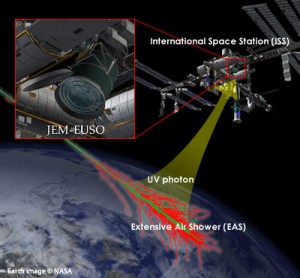 JEM-EUSO is an international project aimed at the building of a long lasting space observatory dedicated to the study and detection of Ultra-High Energy Cosmic Rays (UHECR) and E > 100 EeV energy neutrinos. Thanks to the study of the nature and origin of UHECR basic fundamental physics and high energy astrophysics problems have been addressed.The research field and the scientific goals of JEM-EUESO also reach out to gamma and high energy neutrinos detection, to the study of galactic magnetic fields and possible relativity tests and high energy quantum gravity effects. Furthermore, during the course of the mission, JEM-EUSO will be able to carry out a systematic observation of atmospheric phenomena over the Earth’s surface.
JEM-EUSO is an international project aimed at the building of a long lasting space observatory dedicated to the study and detection of Ultra-High Energy Cosmic Rays (UHECR) and E > 100 EeV energy neutrinos. Thanks to the study of the nature and origin of UHECR basic fundamental physics and high energy astrophysics problems have been addressed.The research field and the scientific goals of JEM-EUESO also reach out to gamma and high energy neutrinos detection, to the study of galactic magnetic fields and possible relativity tests and high energy quantum gravity effects. Furthermore, during the course of the mission, JEM-EUSO will be able to carry out a systematic observation of atmospheric phenomena over the Earth’s surface.
The detection technique is based on the collision between a UHER and the atmosphere and the following production of Extensive Air Showers (AIS). JEM-EUSO observes the fluorescence light radiated by the nitrogen molecules excited by the charged EAS particles and detects the signal reflected on Earth for the Cherenkov effect associated to the air shower. The view field of the ISS quota (FoV di ±30°) corresponds to a ground area of observation of over 1.9 x 105 km2. The detector’s threshold energy is of about 3×1019 eV. Increasing the energy and exposition threshold is possible thanks to the inclination of the telescope from a nadir position to a ‘tilted’ one, allowing for an extension of the observation field of up to 1021 eV.
The program is currently moving forward step by step. Originally designed to be installed on the ISS “Japanese Experiment Module”, managed by the Japan Aerospace Exploration Agency (JAXA), the mission is currently in an advanced research phase to be submitted to the next “Call” and “Announcement of Opportunity” of ISS missions and/or free-flyer, by NASA and ESA.
In the meantime, over the last few years, several JIM-EUSO pathfinders were built to test the hardware in real working conditions, in space, in high atmosphere and on the ground.
The first, EUSO-Balloon, a stratospheric balloon, was successfully launched in August 2014 from a base in Canada; the second, EUSO-TA, on the ground, installed at the Utah Telescope Array site, has been operational and collecting data since the first months of 2015. A third pathfinder, Mini-EUSO, approved by the Roscosmos Russian Space Agency and by ASI, will be installed on ISS in 2017 to carry out UV observations and measurements of the Earth’s atmosphere.
Another balloon launch, long lasting and with hyper pressured balloon, EUSO-SPB, is going to be launched from New Zealand in spring 2017 to observe cosmic air showers in high atmosphere.
The international collaboration JEM-EUSO involves 16 Countries, 90 Institutions and over 300 researchers.
Jem-EUSO
Latest modified:
24 May 2016
 INFN-LNF Laboratori Nazionali di Frascati
INFN-LNF Laboratori Nazionali di Frascati